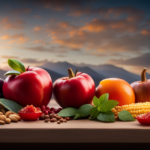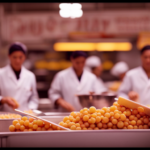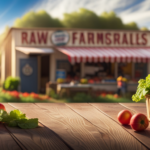Getting Started with Raw Food
What Are Raw Materials In Food Industry
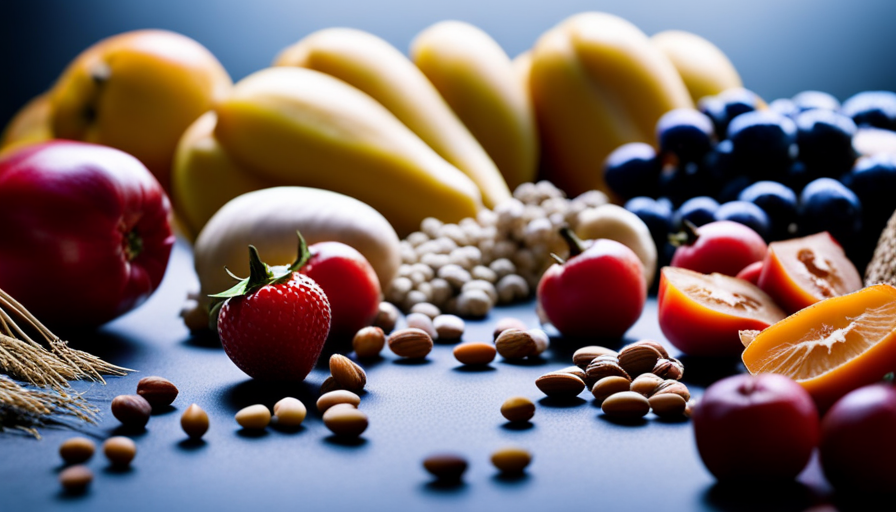
In the expansive realm of the food industry, each delicious dish starts with a simple raw ingredient. These raw ingredients, much like the foundation of a work of art, have the ability to delight our senses and provide nourishment to our bodies.
Picture a symphony of vibrant fruits and vegetables, grains and cereals that dance together to form the foundation of our meals.
As I delve into this intriguing topic, I invite you to join me on a journey through the bountiful fields of the food industry, where the freshest produce, succulent meats, and creamy dairy products await.
We will explore the essential oils and fats that add richness to our culinary delights, as well as the additives and preservatives that ensure their longevity.
Additionally, we will uncover the crucial role of packaging materials, water, and waste management in this complex ecosystem.
So, fasten your seatbelts and prepare to unravel the secrets behind the raw materials that transform our everyday sustenance into extraordinary feasts.
Key Takeaways
- Raw materials in the food industry, such as fruits, vegetables, grains, and meats, are essential for taste, nutrition, and texture in food products.
- Preservation techniques like canning, freezing, and drying are commonly used for fruits to maintain their quality and extend their shelf life.
- Vegetable processing involves washing, peeling, cutting, and packaging to ensure safety and convenience for consumers.
- Grains and cereals, including staple grains like wheat, rice, and corn, are versatile ingredients that provide energy and essential nutrients, but their production can have negative environmental impacts.
Fruits and Vegetables
You’ll find that fruits and vegetables, with their vibrant colors and diverse flavors, are indispensable raw materials in the food industry. They play a crucial role in providing essential nutrients, adding texture, and enhancing taste in various food products.
Fruit preservation is a common method used to extend the shelf life of fruits while maintaining their nutritional value. Techniques such as canning, freezing, and drying are employed to prevent spoilage and ensure availability throughout the year.
Moreover, vegetable processing involves transforming raw vegetables into convenient forms for consumption. This includes washing, peeling, cutting, and packaging to meet consumer demands. Additionally, vegetables can be blanched, steamed, or cooked to improve their digestibility and enhance flavors.
Both fruits and vegetables are also used as ingredients in a wide range of food products, including juices, sauces, soups, and salads. Their natural sweetness and unique flavors provide a refreshing and nutritious addition to these products.
Moving on to grains and cereals, these staples offer a rich source of carbohydrates and are extensively utilized in the food industry for their versatility and nutritional benefits.
Grains and Cereals
Grains play a crucial role in staple foods as they provide a significant source of energy, carbohydrates, and essential nutrients. They are widely consumed globally and are a staple in many diets.
When it comes to processing methods for grains, there are various techniques employed to enhance their digestibility, taste, and shelf life. These methods include milling, grinding, and cooking, which can greatly influence the texture and flavor of the final product.
Role of Grains in Staple Foods
Imagine walking into a bustling kitchen where the aroma of freshly baked bread fills the air, and as you glance around, your eyes are drawn to the sight of golden, steaming loaves made from the humble yet essential grains.
Grains, such as wheat, rice, and corn, play a crucial role in staple foods and provide a significant portion of our daily nutrition. They are rich in carbohydrates, fiber, vitamins, and minerals, making them an important source of energy and essential nutrients.
However, the production of grains can have a significant impact on the environment, with issues such as deforestation, water pollution, and greenhouse gas emissions. Nevertheless, there are various processing methods for grains that can minimize these negative effects. These techniques range from traditional methods, like milling and grinding, to modern techniques, such as extrusion and fortification.
Processing Methods for Grains
One interesting statistic to grab your attention is that processed grains account for over 50% of the average person’s daily caloric intake. Grain processing techniques play a crucial role in transforming raw grains into various food products.
These techniques include milling, grinding, and refining, which remove the outer layers of the grain, resulting in a finer texture and longer shelf life. However, it’s important to note that processing can significantly reduce the nutritional benefits of whole grains.
Whole grains, such as brown rice and whole wheat, are rich in fiber, vitamins, minerals, and antioxidants. These nutrients are often stripped away during processing, leaving behind refined grains that are lower in nutritional value.
As we transition to the subsequent section about meats and poultry, it’s essential to consider the impact of processing on the overall nutritional quality of our food.
Meats and Poultry
In the food industry, various types of meat are used as key ingredients in a wide range of products. These meats include beef, pork, poultry, and fish, each providing unique flavors and textures.
Meat processing is an essential step in the production of food, involving various techniques such as grinding, curing, and smoking to enhance flavor and improve shelf life.
To ensure consumer safety, stringent standards are implemented, including guidelines for proper handling, storage, and cooking temperatures for meat products.
Different Types of Meat Used in the Food Industry
There’s a wide variety of meat used in the food industry, ranging from beef and pork to poultry and seafood. Different cuts of meat are used to create a diverse range of dishes, each requiring specific cooking techniques to bring out their best flavors and textures. For example, beef can be used in dishes like steaks, roasts, and ground beef, while pork is commonly used in sausages, bacon, and ham. Poultry, such as chicken and turkey, is often used in various cuts like breasts, thighs, and drumsticks. Seafood, including fish and shellfish, offers a wide array of options like fillets, steaks, and whole fish. Understanding the different cuts and cooking techniques allows chefs and food manufacturers to create delicious and varied meat dishes for consumers. Moving on to the next subtopic of meat processing and safety standards, it is crucial to ensure that these raw materials are handled and processed in a safe and hygienic manner.
Meat Processing and Safety Standards
After discussing the different types of meat used in the food industry, it’s crucial to understand the importance of meat processing and safety standards. Meat processing regulations play a vital role in ensuring the quality and safety of meat products.
These regulations are put in place to prevent foodborne illnesses and maintain the integrity of the meat industry. To achieve these goals, several safety measures are implemented during the meat processing process. These measures include proper sanitation practices, temperature control, regular inspections, and adherence to strict hygiene protocols.
Additionally, it’s essential for meat processors to follow guidelines for proper handling, storage, and transportation of meat products to prevent contamination. By implementing these safety standards, the risk of foodborne illnesses caused by contaminated meat can be significantly reduced. This ensures that consumers can have confidence in the safety and quality of the meat products they consume.
Transitioning into the subsequent section about dairy products, it’s important to note that similar safety standards and regulations also apply to the dairy industry.
Dairy Products
You may marvel at the multitude of milky marvels that make up the raw materials used in the dairy industry. Dairy farming practices play a crucial role in ensuring the quality and safety of dairy products. Farmers follow strict guidelines to maintain the health and well-being of their cows, including providing them with a balanced diet, proper housing, and regular veterinary care. These practices ensure that the milk produced is of high quality and free from contaminants.
Dairy products are not only delicious but also highly nutritious. They’re an excellent source of essential nutrients such as calcium, protein, vitamins, and minerals. These nutrients are vital for the growth and development of our bodies, particularly for building strong bones and teeth. The nutritional value of dairy products makes them an important part of a balanced diet for people of all ages.
Transitioning into the subsequent section about ‘oils and fats,’ it’s important to note that while dairy products provide valuable nutrients, they also contain varying amounts of fats. These fats contribute to the flavor and texture of dairy products but should be consumed in moderation. To meet the diverse needs of consumers, the food industry also relies on oils and fats from other sources.
Oils and Fats
Oils and fats play a crucial role in enhancing the flavor and texture of various dishes, adding a rich and satisfying element to our meals. When it comes to the food industry, oils are extracted from various sources such as plants, seeds, and fruits. Common extraction methods include mechanical pressing, solvent extraction, and cold-pressing. These methods ensure that the oils retain their natural flavors and nutrients.
There are different types of oils and fats used in the food industry. Some examples include vegetable oils like olive oil, sunflower oil, and coconut oil, as well as animal fats like butter and lard. Each type of oil has its own unique characteristics and culinary uses.
Oils and fats also have health benefits. They provide essential fatty acids that our bodies need for proper growth and development. Additionally, some oils, like olive oil, are rich in monounsaturated fats, which can help lower bad cholesterol levels and reduce the risk of heart disease.
Moving on to the next section about sweeteners and flavorings, we explore how these ingredients contribute to the taste and appeal of our favorite foods.
Sweeteners and Flavorings
Sweeteners and flavorings add a delightful burst of sweetness and flavor, transforming our favorite dishes into irresistible culinary masterpieces.
In the food industry, sweeteners are produced through various methods. One common method is the extraction of natural sugars from fruits or plants, such as sugar cane or corn. These sugars are then processed to remove impurities, resulting in a pure form of sweetener. Additionally, artificial sweeteners are created through chemical processes to mimic the taste of sugar without the calories.
The flavorings industry is equally fascinating. It involves the creation of compounds that enhance the taste of our food. Flavorings are produced using both natural and artificial ingredients. Natural flavorings are derived from plants, herbs, or other natural sources, while artificial flavorings are chemically synthesized to replicate the taste of natural substances. These flavorings are carefully crafted to provide a specific taste profile, whether it be sweet, savory, or spicy.
Moving on to the next section about additives and preservatives, it is important to note that these substances play a crucial role in extending the shelf life of food products.
Additives and Preservatives
Additives and preservatives are essential components in the production of processed foods, allowing them to maintain their quality and freshness for longer periods of time. Interestingly, studies have shown that the use of preservatives has increased by 50% in the past decade alone.
Additives in beverages: Beverages often contain additives such as artificial sweeteners, colors, and flavor enhancers. These additives not only improve the taste but also help in preserving the beverage for a longer shelf life. However, it’s important to note that excessive consumption of certain additives, like artificial sweeteners, may have adverse health effects.
Preservatives in baked goods: Baked goods, such as bread, cakes, and cookies, often contain preservatives to prevent spoilage and extend their shelf life. Common preservatives used in baked goods include calcium propionate, sodium benzoate, and sorbic acid. These preservatives inhibit the growth of mold and bacteria, ensuring that the baked goods remain fresh and safe to consume for a longer duration.
Emulsifiers in sauces and dressings: Emulsifiers are additives commonly used in sauces and dressings to prevent separation of ingredients. They help create a stable, smooth texture and improve the overall mouthfeel of the product.
Antioxidants in oils and fats: Oils and fats are prone to oxidation, which can lead to rancidity and off-flavors. Antioxidants such as vitamin E and citric acid are added to oils and fats to slow down the oxidation process and extend their shelf life.
Stabilizers in dairy products: Dairy products like yogurt and ice cream often contain stabilizers such as carrageenan, guar gum, and pectin. These additives help maintain the texture, prevent syneresis (the release of water), and improve the overall stability of the products.
In the next section about packaging materials, we’ll explore how proper packaging plays a crucial role in preserving the quality and safety of processed foods.
Packaging Materials
Packaging plays a crucial role in the food industry as it not only protects the product but also helps in maintaining its quality and freshness. It ensures that the food reaches the consumers in a safe and hygienic manner.
In recent years, there’s been a growing emphasis on sustainable packaging solutions that minimize waste and environmental impact, such as using recyclable or biodegradable materials. These advancements aim to address the increasing consumer demand for eco-friendly packaging options.
Importance of Packaging in the Food Industry
Imagine the convenience and freshness that comes with properly sealed and labeled packages in the food industry. Packaging plays a crucial role in preserving the quality and safety of food products. It not only protects the food from external factors such as light, moisture, and air, but also helps in maintaining its nutritional value and extending its shelf life. Additionally, packaging serves as a medium for branding and communicating essential information to consumers, such as ingredients, nutritional facts, and allergen warnings. Consumer preferences are heavily influenced by the packaging design, as it represents the brand’s image and values. To highlight the significance of packaging, consider the following table:
| Importance of Packaging in the Food Industry |
|---|
| Ensures product safety and quality |
| Extends shelf life |
| Enhances brand image |
| Provides essential information to consumers |
| Influences consumer purchasing decisions |
Sustainable packaging solutions are the next step towards creating a more environmentally friendly food industry.
Sustainable Packaging Solutions
After discussing the importance of packaging in the food industry, it’s crucial to explore sustainable packaging solutions that can help reduce environmental impact.
Sustainable packaging solutions are becoming increasingly popular as companies strive to minimize waste and promote eco-friendly practices. These solutions involve using innovative packaging designs that are made from renewable or recycled materials, such as biodegradable plastics or plant-based fibers. By opting for sustainable packaging, companies can reduce their carbon footprint and contribute to a more sustainable future.
- Biodegradable plastics
- Plant-based fibers
- Recycled materials
Now, let’s delve into another essential aspect of the food industry: water.
Water
Water is an essential ingredient that nourishes our food and quenches our thirst. In the food industry, water quality plays a crucial role in ensuring the safety and taste of the products we consume. Contaminated water can lead to foodborne illnesses and affect the overall quality of the final product. Therefore, it is necessary to prioritize water quality in all stages of food production.
Water scarcity is also a significant concern in the food industry. As the global population continues to grow, so does the demand for water. Agriculture, which is the primary source of raw materials for the food industry, requires substantial amounts of water for irrigation. However, with limited freshwater resources, it is crucial to adopt sustainable practices to conserve water and ensure its availability for future generations.
By implementing efficient irrigation methods, such as drip irrigation or precision farming, the food industry can reduce water usage and minimize the impact on water scarcity. Additionally, treating and reusing water in food processing facilities can further contribute to water conservation efforts.
Understanding the importance of water quality and scarcity is essential for the food industry to develop sustainable practices that minimize water waste and ensure the long-term availability of this vital resource. By doing so, we can transition into the subsequent section about byproducts and waste management.
Byproducts and Waste Management
To effectively manage byproducts and waste, you need to ask yourself: How can you ensure that every aspect of your production process is optimized and waste is minimized?
Byproducts in the food industry can be utilized in various ways to reduce waste. One approach is to repurpose byproducts as ingredients in other products, such as using fruit peels to make natural flavorings or using vegetable scraps for compost.
Another method is to convert byproducts into valuable resources, such as using food waste to produce biogas or extracting nutrients from byproducts for use in animal feed. By implementing these strategies, companies can not only reduce waste but also generate additional revenue streams.
Waste reduction is crucial for sustainability in the food industry, as it minimizes environmental impact and conserves resources. It is essential for companies to prioritize waste management and explore innovative ways to utilize byproducts effectively. By doing so, we can create a more circular and resource-efficient food system.
Frequently Asked Questions
Are there any specific regulations or standards in place for the use of raw materials in the food industry?
Yes, there are specific regulations and standards in place for the use of raw materials in the food industry. These regulations ensure the safety and quality of raw materials used in food production. They cover aspects such as sourcing, handling, storage, and transportation of raw materials. Quality control measures are implemented to test and verify the safety, authenticity, and nutritional value of raw materials. Compliance with these regulations is crucial to maintain the integrity of the food supply chain and protect consumer health.
How do food manufacturers ensure the safety and quality of raw materials used in their products?
Ensuring food safety and maintaining raw material quality control is crucial for food manufacturers. To achieve this, rigorous processes are implemented.
For instance, my company conducts regular supplier audits to assess their compliance with safety and quality standards. Additionally, we perform thorough testing and analysis on incoming raw materials to ensure they meet our specifications.
This comprehensive approach guarantees that the raw materials used in our products are safe and of the highest quality.
What are some common challenges faced in sourcing raw materials for the food industry?
Challenges in sourcing raw materials for the food industry are abundant due to supply chain complexities. Ensuring a consistent and reliable supply of high-quality ingredients can be a daunting task. Factors like fluctuating prices, weather conditions, and geographical limitations can disrupt the procurement process.
Additionally, maintaining traceability and meeting strict safety standards further complicate the sourcing process. To overcome these challenges, food manufacturers employ rigorous quality control measures and establish strong relationships with trusted suppliers.
How are raw materials processed or treated before being used in food production?
Raw material processing in the food industry is a critical step in ensuring the quality and safety of the final product. Before being used in food production, raw materials undergo various treatments to eliminate contaminants and enhance their properties. This can include washing, grinding, heating, and fermenting, among other techniques.
The importance of raw material quality cannot be overstated, as it directly impacts the taste, texture, nutritional value, and overall safety of the food we consume. Thus, rigorous processing measures are employed to maintain the highest standards.
Can you provide examples of innovative or alternative raw materials being used in the food industry?
Plant-based substitutes and novel protein sources are increasingly being used in the food industry as innovative and alternative raw materials. These include ingredients derived from plants, such as soy, pea, and almond, which are used as substitutes for traditional animal-based products.
Additionally, novel protein sources like insect protein and algae are being explored as sustainable alternatives. These innovative raw materials offer a wide range of nutritional benefits and help meet the growing demand for environmentally friendly and ethical food options.
What are the Raw Materials Used in the Raw Food Movement?
The raw food movement emphasizes natural, unprocessed ingredients. Common raw materials used include fruits, vegetables, nuts, seeds, and grains. These ingredients are often combined in creative ways to make raw food crafts pairing delicious and nutritious meals and snacks.
Conclusion
In conclusion, as I reflect on the vast array of raw materials used in the food industry, I am reminded of the intricate tapestry that sustains our nourishment. Like the harmonious symphony of nature, fruits and vegetables, grains and cereals, meats and poultry, dairy products, oils and fats, additives and preservatives, packaging materials, water, and even the byproducts and waste management all play their part in creating the sustenance we rely on.
Let us appreciate these raw materials, for they’re the foundation of our very existence, and embrace the delicate balance they bring to our lives.
With her ability to convey complex concepts in a clear and accessible manner, Belinda ensures that readers of all backgrounds can grasp the benefits and techniques of raw food. She excels at breaking down scientific information into digestible pieces, allowing readers to understand the impact of raw food on their bodies and encouraging them to make informed choices about their diet.
One of Belinda’s notable contributions to rachaelsrawfood.com is her collection of mouthwatering recipes. She delights in experimenting with various combinations of raw ingredients, exploring innovative ways to create delicious and nutritious meals. Belinda’s recipes showcase the incredible flavors and textures of raw food and emphasize its versatility, dispelling any misconception that a raw food diet is limited or monotonous.
In addition to her writing responsibilities, Belinda actively engages with the raw food community, attending workshops, seminars, and conferences to expand her knowledge and network. She enjoys connecting with like-minded individuals, exchanging ideas, and staying up to date with the latest trends and advancements in the field of raw food nutrition.
Getting Started with Raw Food
Does Raw Food Make Dogs Constipated? Find Out Here
Observe the signs of constipation in dogs on a raw food diet; discover how to ensure their digestive health. What solutions exist?
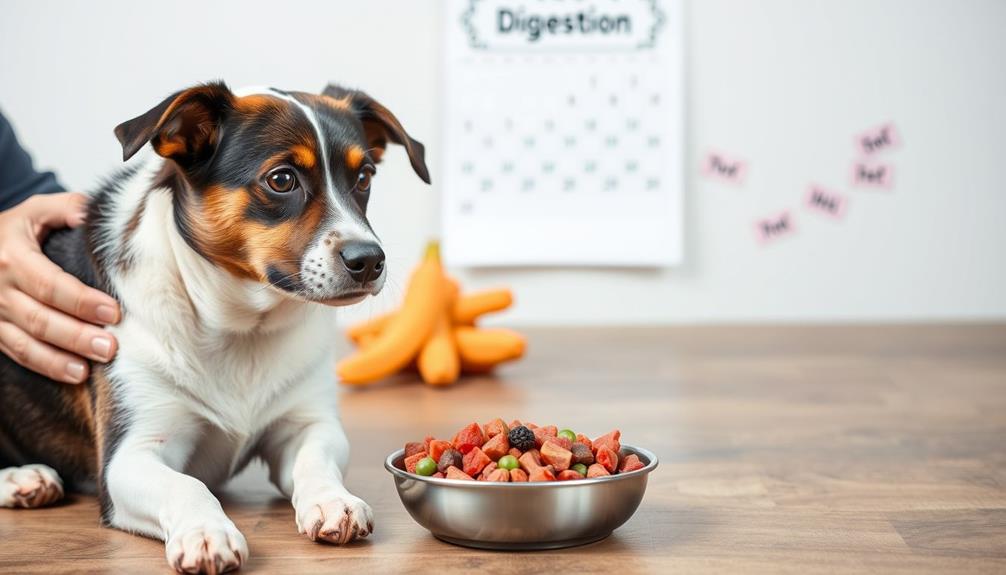
Feeding your dog a raw food diet can indeed cause constipation if it isn't balanced right. Excessive bone content might lead to hard stools, while not including enough fiber from fruits and vegetables can worsen the issue. Dehydration is also common with raw diets, contributing to stool hardness. If you notice signs like straining to defecate or rock-hard stools, it's important to adjust the diet. Adding fiber-rich foods like pumpkin and keeping your dog hydrated are key. There's more you can do to guarantee a healthy digestion for your dog, so keep exploring options for their diet.
Key Takeaways
- Raw diets can lead to constipation due to excessive bone content resulting in hard stools.
- Insufficient fiber from a lack of fruits and vegetables can exacerbate digestive issues.
- Dehydration is common in raw diets, which contributes to stool hardness.
- Rapid transitions to a raw diet without gradual adjustments may disrupt a dog's digestion.
- Regular monitoring of stool consistency and dietary balance is essential for preventing constipation.
Understanding Dog Constipation
Constipation in dogs can be a concerning issue for pet owners, and it's important to recognize the signs early. You might notice that your dog hasn't had a bowel movement for over 24 hours, is straining while trying to defecate, or producing rock-hard stools. These symptoms indicate that your dog's digestive tract needs attention.
Diet plays an essential role in your dog's bowel health, and understanding proper hamster care can help you appreciate the importance of nutrition in pet health. If your dog is on a raw diet, insufficient fiber and excessive bone content can contribute to constipation. It's crucial to provide enough fiber to help your dog maintain regular bowel movements. Foods like pumpkin and leafy greens can be excellent additions to their diet.
Additionally, keep an eye on your dog's hydration and make sure they get plenty of exercise. Both of these factors are significant for promoting healthy digestion and preventing constipation.
If you're concerned about your dog's condition, consider adjusting their diet by reducing bone content and incorporating fiber-rich foods. By taking these steps, you can help your dog overcome constipation and support their overall health.
Causes of Constipation in Raw Diets
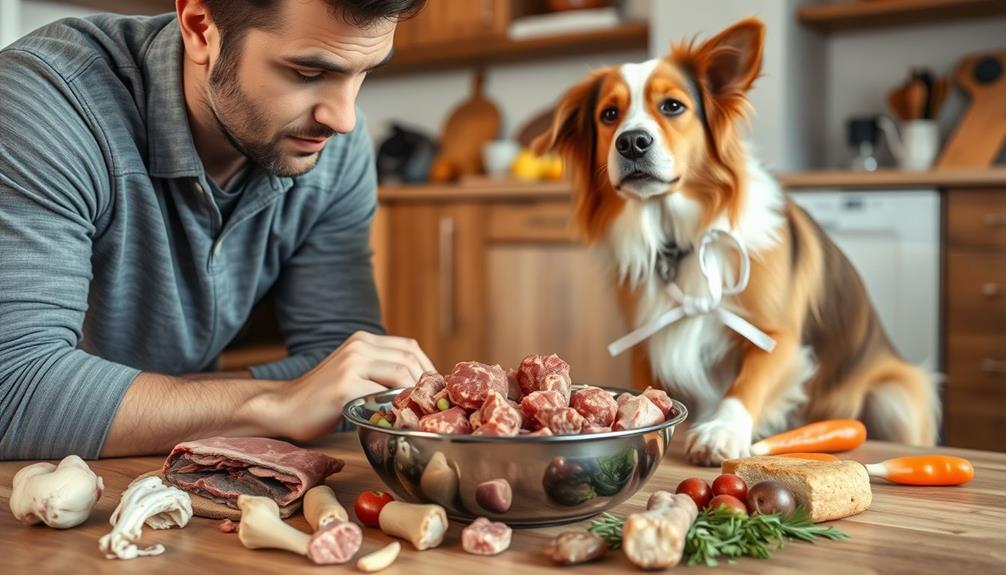
A raw diet can sometimes lead to constipation in dogs, primarily due to excessive bone content. When the diet consists of too many bones, it can result in hard stools that hinder regular bowel movements.
Additionally, insufficient fiber intake from a lack of fruits and vegetables can exacerbate the problem. It's essential to incorporate fiber-rich foods like pumpkin and leafy greens to support healthy digestion, as recommended in gout nutrition guidelines.
Dehydration also plays a significant role in constipation. Since raw diets often contain less moisture than processed foods, your dog may not be drinking enough water, further contributing to hard stools.
Stress, changes in routine, or dietary imbalances can influence gut motility, leading to irregular bowel movements as well.
Moreover, if you shift your pet to a raw diet too quickly without a gradual introduction of new foods, it can disrupt their digestive system. This sudden change may result in constipation or other gastrointestinal issues.
To prevent these causes of constipation, verify that your dog's raw diet is balanced and includes sufficient fiber and hydration. This way, you can help maintain your dog's digestive health.
Signs and Symptoms to Observe

Recognizing the signs and symptoms of constipation in your dog is essential for timely intervention. Pay close attention to any lack of stool for over 24 hours, as this can be a clear indication that your dog is experiencing constipation.
If you notice your dog is straining during defecation, it's vital to take action. Straining often accompanies hard stools that resemble pebbles, signaling that your dog may be in discomfort. Additionally, providing your dog with healthy snacks can promote better digestion and overall health, potentially mitigating constipation issues.
Behavioral changes can also be significant. If your dog seems reluctant to move, avoids activities they usually enjoy, or shows signs of discomfort while attempting to relieve themselves, these may be warning signs of constipation.
It's important to monitor stool consistency regularly. Hard stools can lead to further complications, so keeping an eye on your dog's bathroom habits is key.
Dietary Adjustments for Relief
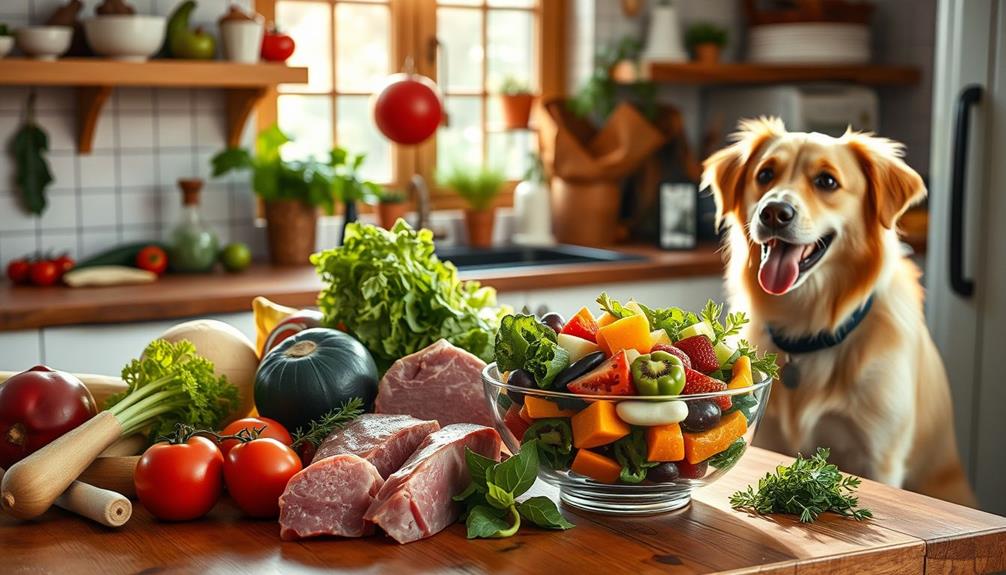
Making dietary adjustments can greatly help alleviate your dog's constipation. Start by reducing the frequency of raw meaty bones in their diet, as these can lead to drier, harder stools.
Instead, focus on incorporating extra fruits and vegetables, like pumpkin or leafy greens, which provide essential fiber that aids in regulating bowel movements. Additionally, guaranteeing proper hydration is vital; consider how air quality considerations can parallel maintaining your dog's overall health, including digestive wellness.
Feeding a balanced raw diet consisting of 80% muscle meat, 10% bone, and 10% offal guarantees your dog gets adequate moisture and nutrients, promoting healthy digestion.
Pureed pumpkin or canned unsweetened pumpkin can be particularly effective, thanks to its high fiber content, making it easier for your dog to defecate without straining.
Don't forget about hydration! Make sure your dog has access to fresh water or bone broth, as regular hydration is essential for maintaining stool consistency and preventing constipation.
By making these dietary adjustments, you'll create a more balanced raw food experience that supports your dog's digestive health and helps alleviate constipation.
Supplement Options for Digestive Health
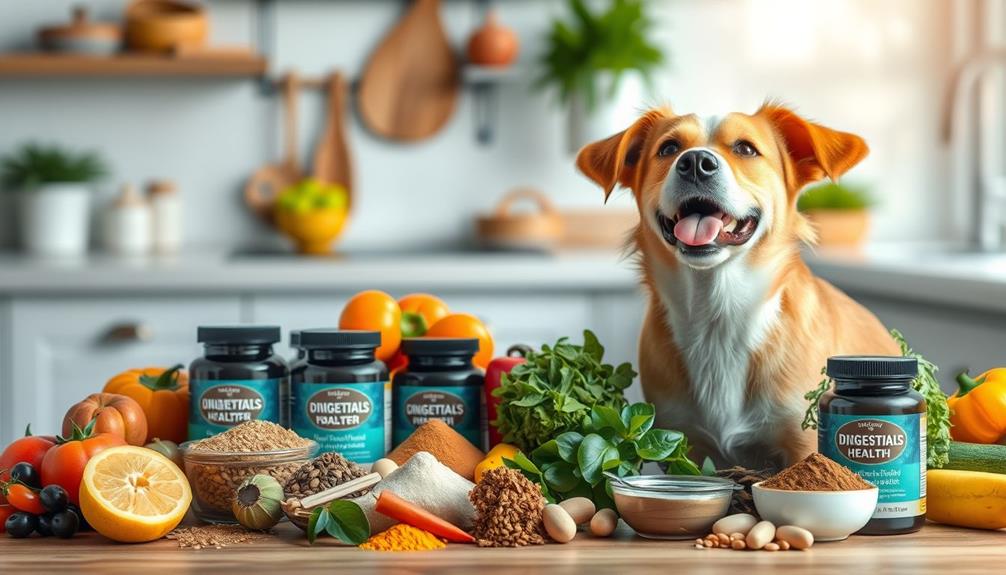
How can you enhance your dog's digestive health while minimizing constipation? Exploring effective supplement options can make a significant difference. Here are some to evaluate:
- Probiotics: These promote a diverse gut microbiome, which is essential for good digestion and can help mitigate issues such as gastrointestinal issues.
- Digestive enzymes: They help break down raw proteins and fats, improving nutrient absorption.
- Slippery elm: This natural remedy soothes the gastrointestinal tract and creates a protective mucous lining. A dosage of ¼ teaspoon per 10 lbs of body weight is recommended.
- Leafy greens: Incorporating fiber-rich foods like kale or spinach can regulate bowel movements, alleviating constipation.
- Omega-3 oil: Regular supplementation with this healthy oil supports overall digestive health and improves stool consistency.
When to Consult a Veterinarian

If your dog hasn't had a bowel movement in over 24 hours, it's time to consult a veterinarian.
It's important to keep an eye on your dog's overall behavior and health, as changes can indicate underlying issues that may require immediate attention.
Look out for persistent straining, discomfort, or any behavioral changes that indicate pain.
Addressing these signs early can help prevent more serious health issues down the line.
Additionally, emotional and psychological support available for families can be beneficial during such stressful times.
Persistent Lack of Stool
When your dog goes more than 24 hours without a stool, it's time to consult a veterinarian to rule out any serious health issues. A persistent lack of stool can indicate underlying problems that need addressing.
Here are some signs to watch for:
- Decreased energy levels or reluctance to move
- Hard, rock-like stools that signal constipation
- Straining to defecate with little or no output
- Signs of pain during attempts to relieve themselves
- Changes in appetite or behavior, indicating discomfort
If your dog's raw food diet lacks fiber, it could cause constipation, leading to infrequent dogs' bowel movements. Adding vegetables such as spinach, carrots, and sweet potatoes to their diet can help increase the fiber content and improve their digestion. It is important to consult with a veterinarian before switching to raw dog food, as they can provide guidance on the best diet for your dog’s specific needs. In some cases, adding a fiber supplement may also be necessary to ensure your dog’s digestive health.
Creating a personal budget for your pet's dietary needs can guarantee they receive the right nutrients. Loose stools can also disrupt gut health, making it essential to maintain a balanced diet.
If you notice any of these symptoms, don't hesitate to seek veterinary advice. Early intervention is key to identifying and treating the root cause of your dog's persistent lack of stool.
Delaying could complicate the situation, so it's best to act promptly. Remember, your dog's well-being depends on your vigilance in recognizing these signs!
Straining and Discomfort Signs
Straining to defecate can be a clear sign that your dog is experiencing constipation, and it's important to recognize this symptom early.Breast cancer symptoms in dogs can sometimes mimic signs of discomfort, so it's vital to differentiate between the two. If you notice your dog straining excessively or having difficulty passing stool, it's necessary to consult a veterinarian, especially if this persists. Signs of discomfort, like whining or trembling while attempting to defecate, should prompt an immediate visit to the vet.
A lack of bowel movements for more than 24 hours is a significant indicator of constipation and requires professional evaluation to rule out any underlying issues. Additionally, if your dog produces rock-hard stool consistently, this often signifies constipation, and you should seek veterinary advice.
Keep an eye on any changes in your dog's behavior; decreased activity levels or reluctance to move may also signal discomfort related to being constipated.
Addressing these signs of discomfort promptly can help prevent more serious health problems down the line. Remember, when in doubt about your dog's bowel habits or overall well-being, don't hesitate to reach out for a veterinary consultation. Your dog's health and comfort should always come first.
Behavioral Changes and Pain
Recognizing behavioral changes in your dog can provide important clues about their health, especially regarding constipation.
Similar to individuals with BPD dynamics in relationships, dogs may exhibit changes in behavior when experiencing discomfort or pain. If your dog exhibits any of the following signs, it's time to reflect on a vet consultation:
- Reluctance to move or play
- Straining and difficulty when trying to defecate
- Whining or trembling during attempts to have a bowel movement
- Rock-hard stools that are difficult to pass
- An absence of bowel movements for more than 24 hours
These signs of pain and discomfort can indicate that your dog needs immediate attention.
Straining to defecate is a clear indicator of constipation, and if your pet struggles for over a day, it may suggest a more serious underlying issue. Obvious signs of distress during defecation, such as whining, should never be ignored.
If you notice any of these behavioral changes, don't hesitate to consult your vet.
Early intervention can prevent complications and guarantee your dog's digestive health is maintained.
Frequently Asked Questions
Is It Normal for Dogs to Poop Less on a Raw Diet?
It's normal for dogs to poop less on a raw diet. You'll notice smaller, firmer stools due to higher digestibility. Just keep an eye out for any signs of constipation or distress in your dog.
How Do You Soften a Dog's Poop on a Raw Diet?
Did you know that 60% of dog owners notice firmer stools on a raw diet? To soften your dog's poop, balance their meals, add fiber, guarantee hydration, and encourage daily exercise for ideal digestive health.
What Foods Cause Dogs to Be Constipated?
Certain foods can cause constipation in dogs. High bone content, low-fiber diets, dry kibble, excessive lean meats, and non-digestible items like toys can all contribute to hard stools. Guarantee a balanced diet to prevent this.
How Long Does It Take for a Dog to Digest Raw Food and Poop?
It usually takes your dog 12 to 24 hours to digest raw food, depending on their age and size. You might notice smaller, less frequent stools due to improved nutrient absorption from the diet.
Conclusion
To sum up, while a raw food diet can be beneficial for many dogs, it can also lead to constipation if not balanced properly. Keep an eye on your pup's signs and symptoms, and make dietary adjustments as needed. If the issue persists, don't hesitate to consult your veterinarian, who can help you navigate this digestive maze. Remember, with the right approach, you can keep your dog's tummy happier than a kid in a candy store!
With her ability to convey complex concepts in a clear and accessible manner, Belinda ensures that readers of all backgrounds can grasp the benefits and techniques of raw food. She excels at breaking down scientific information into digestible pieces, allowing readers to understand the impact of raw food on their bodies and encouraging them to make informed choices about their diet.
One of Belinda’s notable contributions to rachaelsrawfood.com is her collection of mouthwatering recipes. She delights in experimenting with various combinations of raw ingredients, exploring innovative ways to create delicious and nutritious meals. Belinda’s recipes showcase the incredible flavors and textures of raw food and emphasize its versatility, dispelling any misconception that a raw food diet is limited or monotonous.
In addition to her writing responsibilities, Belinda actively engages with the raw food community, attending workshops, seminars, and conferences to expand her knowledge and network. She enjoys connecting with like-minded individuals, exchanging ideas, and staying up to date with the latest trends and advancements in the field of raw food nutrition.
Getting Started with Raw Food
Why Is Raw Food Bad for Cats? Essential Information
Overlooking the dangers of raw food diets for cats can lead to serious health risks; discover what you need to know for your feline’s safety.
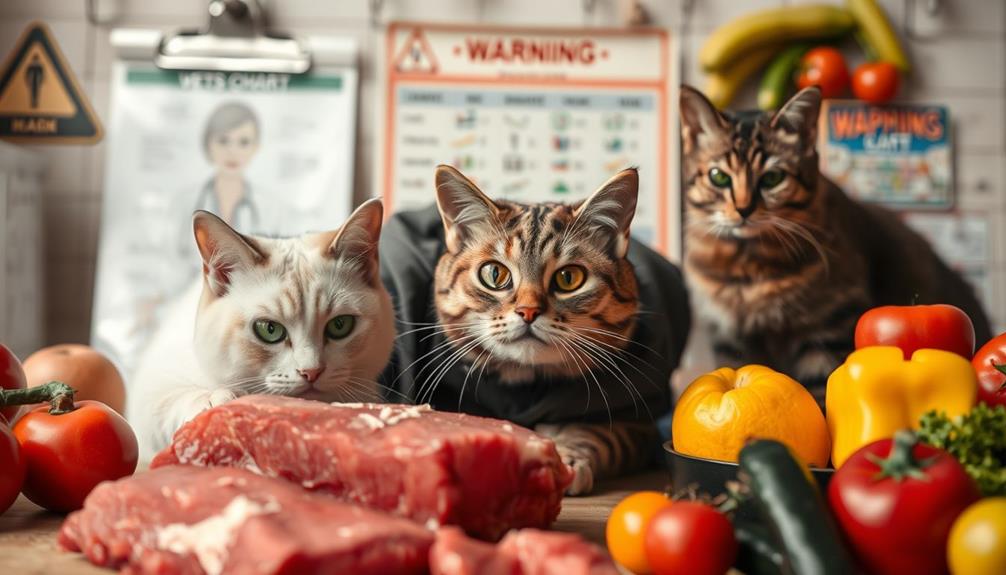
Feeding your cat a raw food diet can be risky due to harmful bacteria like Salmonella and E. coli, which can cause severe gastrointestinal issues such as vomiting and diarrhea. About 25% of raw pet food samples have tested positive for these pathogens. Additionally, raw diets often lack essential nutrients like taurine, which can lead to serious health problems over time. Contamination during preparation increases health risks not just for your cat but for humans as well. Safety practices are vital if you decide to go this route, but there are safer, balanced alternatives that might better meet your cat's needs.
Key Takeaways
- Raw food diets can expose cats to harmful pathogens like Salmonella and E. coli, posing health risks to both pets and humans.
- Nutritional deficiencies are common in raw diets, lacking essential nutrients necessary for a cat's overall health and development.
- Improper preparation and handling of raw food increase the risk of contamination, leading to severe gastrointestinal issues in cats.
- Cats can be asymptomatic carriers of pathogens, increasing the risk of transmitting infections to humans through raw food.
- High-quality commercial cat foods offer balanced nutrition and are safer alternatives, minimizing health risks associated with raw diets.
Health Risks of Raw Food
When considering a raw food diet for your cat, it's vital to understand the health risks involved. Raw food diets can carry significant contamination risks with harmful pathogens such as Salmonella and E. coli. Studies indicate that nearly 25% of raw pet food samples test positive for these bacteria. The CDC estimates that there are about 1.2 million annual cases of foodborne salmonellosis in the U.S., and your cat could act as an asymptomatic carrier, increasing the risk of human exposure.
Additionally, just as in financial planning for elderly care, understanding the long-term impact of dietary choices is important for maintaining overall health and well-being.
Moreover, Listeria monocytogenes, another pathogen found in raw diets, poses serious dangers, especially for vulnerable populations like pregnant women and newborns. Cats fed raw diets may experience gastrointestinal issues such as vomiting and diarrhea, which can lead to severe health consequences for both them and their human caregivers.
Veterinary organizations like the CDC and AVMA strongly advise against raw diets due to these health risks. They emphasize the importance of safe handling practices to minimize contamination, but even with precautions, the dangers of raw pet food remain significant.
Ultimately, you must weigh these risks carefully when considering your cat's diet.
Nutritional Concerns
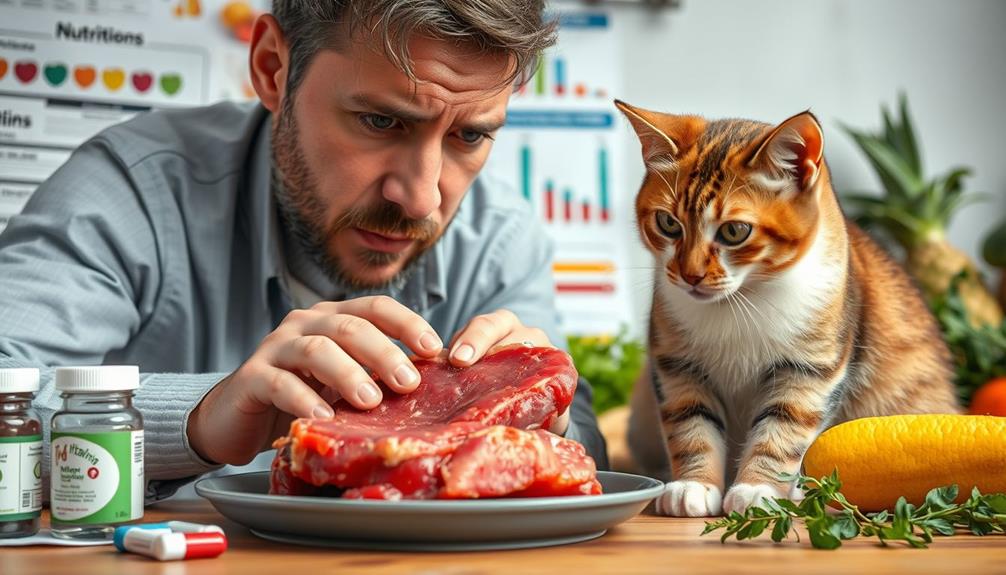
Cats thrive on balanced nutrition, but raw food diets often fall short in providing essential nutrients. Many raw food diets lack essential components like taurine, vitamins A, D, and E, which are critical for your cat's health. Without these essential nutrients, your feline friend could face serious nutritional deficiencies that lead to health issues over time.
Furthermore, it's important to understand the implications of dietary choices on overall health and wellness, as proper budgeting for pet care guarantees your cat receives the best nutrition possible.
Homemade raw diets frequently miss the mark on meeting complete and balanced nutritional requirements. This oversight can result in calcium imbalances, affecting bone health and overall development, particularly in growing cats. In adult cats, these imbalances can also lead to significant health concerns.
Additionally, without veterinary guidance, feeding your cat a raw food diet can be risky. Only a small percentage of analyzed homemade raw diets have been found to be complete and balanced. The potential for harmful bacteria in raw diets can further complicate nutritional adequacy, as it may contribute to nutrient loss.
To guarantee your cat receives the balanced diet they need, consult with a veterinarian before making any changes to their diet, especially if you're considering raw food options.
Pathogen Contamination
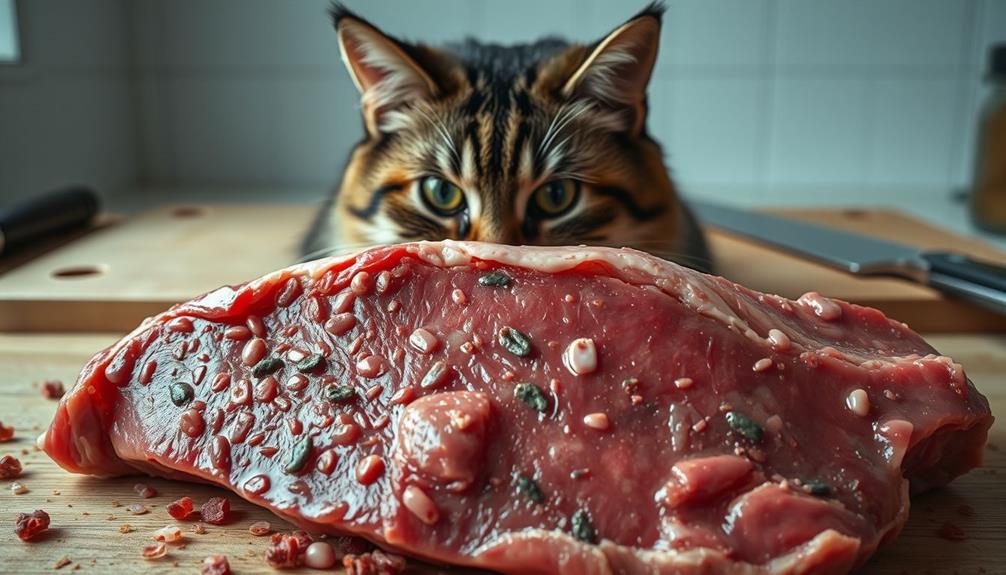
Feeding your cat a raw food diet can open the door to serious health risks, particularly due to pathogen contamination. Studies show that nearly 25% of raw cat food samples are contaminated with harmful bacteria, including Salmonella and Listeria.
These pathogens can pose significant risks not only to your cat but also to your household. Pets with emotional dysregulation, such as those with BPD dynamics in relationships, may also exhibit increased anxiety, making them more vulnerable to health issues.
Salmonella, for instance, causes around 1.2 million human infections each year, with cats often acting as asymptomatic carriers, increasing the chance of transmission to humans.
Listeria monocytogenes, another common threat in raw diets, leads to severe foodborne illnesses, contributing to approximately 1,600 cases and 260 deaths annually in the US. The risks escalate, especially in households with young children or immunocompromised individuals, as they're more vulnerable to these pathogens.
Improper preparation and handling raw food can exacerbate the risks of contamination, making it critical to understand the serious implications of a raw diet.
While your cat may enjoy the taste, the potential health hazards from contaminated raw cat food can lead to dire consequences for both your pet and your family.
Safe Handling Practices
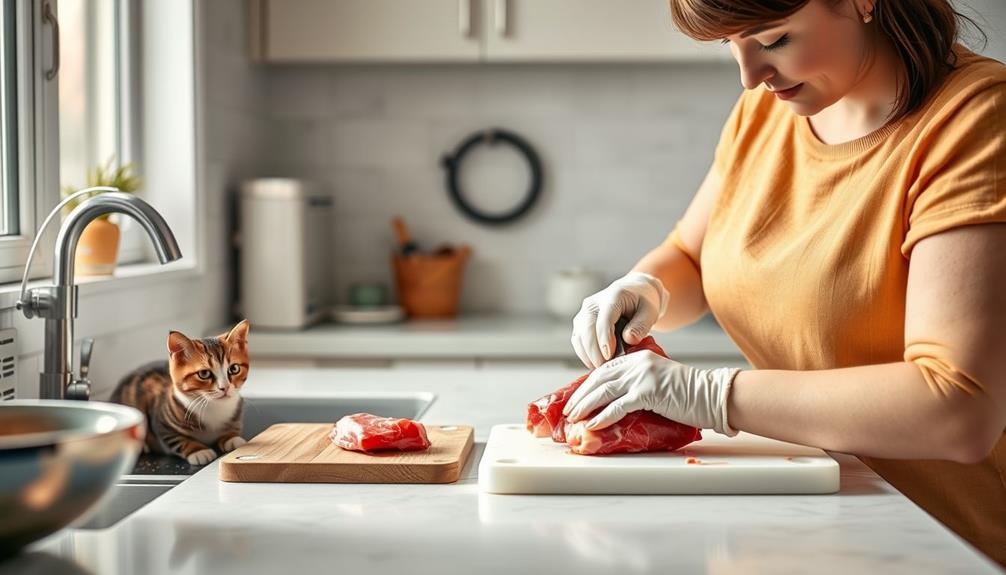
Practicing safe handling techniques is vital to minimize the risks associated with feeding your cat a raw food diet. As a pet parent, you need to be vigilant about harmful bacteria like Salmonella and Listeria that can thrive in raw cat food.
Regularly monitoring your cat's health for any signs of illness can also be beneficial, as certain dietary choices may impact their well-being, including ultimate hamster care. Always wash your hands thoroughly with soap and water after handling any raw food. This simple step helps prevent the spread of these pathogens.
To guarantee a safe environment, clean and disinfect all surfaces, utensils, and feeding dishes that come into contact with raw food. Remember to store raw cat food in the freezer until you're ready to use it, and thaw it safely in the refrigerator or microwave. This prevents bacterial growth and keeps your cat's nutritional needs in check.
Keep raw cat food separate from human food items during storage and preparation to avoid cross-contamination. It's also important to avoid rinsing raw meat before preparation, as this can cause splashing and spread bacteria to surrounding surfaces and utensils.
Alternatives to Raw Diets
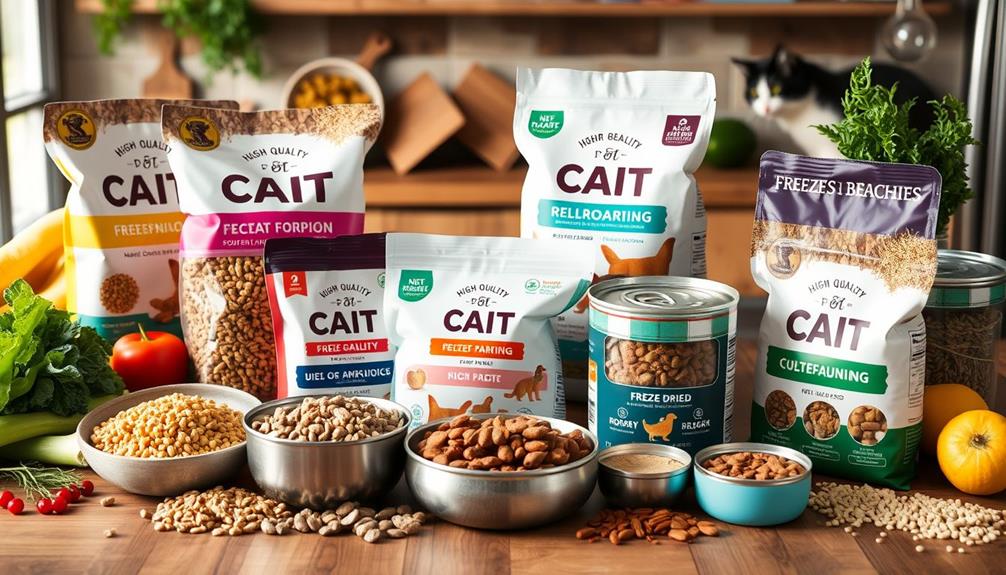
When considering alternatives to raw diets, many pet owners find themselves weighing the benefits of high-quality commercial foods. These commercially prepared options, formulated by veterinary nutritionists, provide a complete and balanced diet that meets your cat's nutritional needs without the risks associated with raw feeding.
Additionally, some commercial diets are specifically designed to support urinary health, which is essential for preventing common feline health issues recommendations for usage based on symptoms.
Cooked food is another excellent choice. It can be tailored to eliminate harmful bacteria, making it a safer alternative to raw diets. High-quality canned cat foods often have higher moisture content, supporting hydration and benefiting your cat's urinary health.
If your cat has food sensitivities or allergies, you might explore limited ingredient diets (LID) or hypoallergenic commercial foods. These options provide safe alternatives without the dangers linked to raw diets.
It's vital to consult with a veterinarian when making dietary changes. They can guide you in selecting high-quality commercial diets or cooked homemade meals that align with your cat's health needs.
Frequently Asked Questions
Why Is Raw Food Bad for Cats?
Raw food diets can expose your cat to harmful bacteria and nutritional deficiencies. They often lack essential nutrients, and unprocessed bones might cause serious injuries. It's best to stick to balanced, vet-recommended diets for your cat's health.
Why Do Vets Say Raw Food Is Bad?
Oh sure, let's serve your cat raw meat like a gourmet delicacy! Vets warn against it because of bacteria, nutrient deficiencies, and potential harm to both your pet and your family. Cooked food's safer, trust them!
Do Vets Recommend a Raw Diet for Cats?
Most vets don't recommend a raw diet for cats due to health risks like bacterial contamination and nutritional imbalances. They suggest opting for high-quality commercial cat foods to guarantee your pet's health and well-being.
What Are the Dangers of Raw Food?
Raw food diets can expose your cat to harmful bacteria like Salmonella and E. coli, leading to severe illness. They might also cause nutrient deficiencies and pose choking hazards from unprocessed bones, risking your cat's health. Additionally, raw food diets can lead to potential dental issues and digestive problems for cats. In fact, some studies have linked raw food diets to an increased risk of tooth decay and gum disease in cats. Furthermore, it’s important to note that raw food and dog constipation can also be a concern, as the lack of fiber in raw diets can lead to bowel irregularities and discomfort for pets. Therefore, it’s crucial to carefully consider the potential risks before deciding to switch your cat to a raw food diet.
Conclusion
In the grand tapestry of feline nutrition, raw food might seem like a tempting thread, but it can unravel quickly with health risks and nutritional concerns. While the allure of a raw diet is strong, remember the hidden dangers lurking within pathogens that can harm your cat. By exploring safer alternatives, you can guarantee your furry friend thrives. After all, a happy cat is a healthy cat, and that's the purrfect goal for every pet owner!
With her ability to convey complex concepts in a clear and accessible manner, Belinda ensures that readers of all backgrounds can grasp the benefits and techniques of raw food. She excels at breaking down scientific information into digestible pieces, allowing readers to understand the impact of raw food on their bodies and encouraging them to make informed choices about their diet.
One of Belinda’s notable contributions to rachaelsrawfood.com is her collection of mouthwatering recipes. She delights in experimenting with various combinations of raw ingredients, exploring innovative ways to create delicious and nutritious meals. Belinda’s recipes showcase the incredible flavors and textures of raw food and emphasize its versatility, dispelling any misconception that a raw food diet is limited or monotonous.
In addition to her writing responsibilities, Belinda actively engages with the raw food community, attending workshops, seminars, and conferences to expand her knowledge and network. She enjoys connecting with like-minded individuals, exchanging ideas, and staying up to date with the latest trends and advancements in the field of raw food nutrition.
Kitchen Essentials for Raw Food Preparation
Which Raw Food Should Be Stored Above? Essential Tips
Learn the crucial hierarchy of raw food storage to prevent cross-contamination and ensure safety—discover the essential tips that could change your kitchen practices!
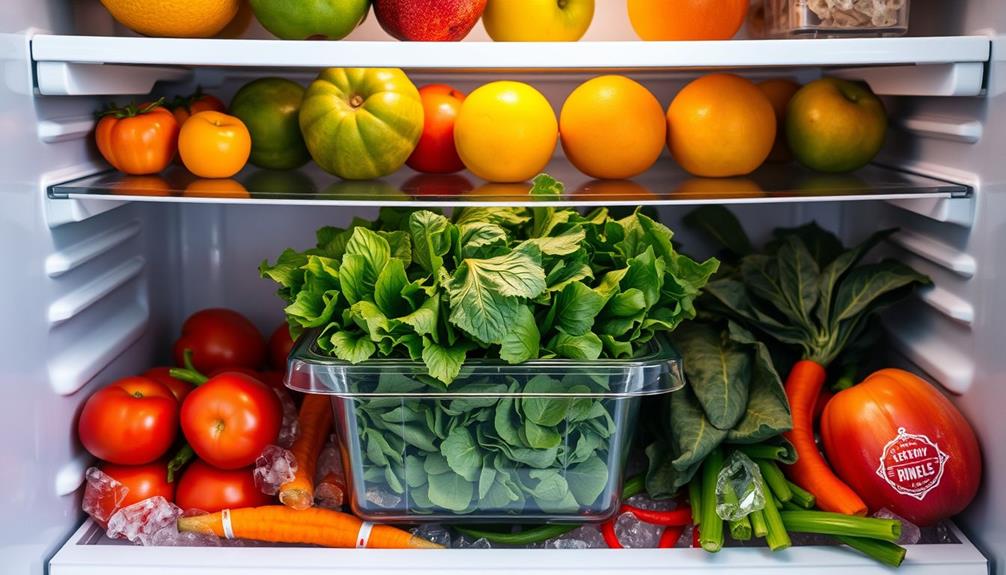
When organizing your refrigerator, always store raw fish on the top shelf. This placement minimizes the risk of cross-contamination with other foods. It's essential to wrap the fish tightly in plastic wrap or foil and keep it in a sealed container to prevent exposure to contaminants. Below the fish, you can store whole cuts of beef and pork on the middle shelf, while ground meats go lower. Finally, raw poultry should be on the bottom shelf to avoid any leakage. Understanding these storage tips can greatly enhance your food safety practices. You'll discover even more helpful advice ahead.
Key Takeaways
- Store raw fish on the top shelf to minimize the risk of cross-contamination with other foods.
- Whole cuts of beef and pork should be placed directly below fish on the middle shelf.
- Ground meats must be stored on the lower middle shelf, beneath whole cuts of beef and pork.
- Raw poultry should always be kept on the bottom shelf to prevent juices from contaminating other items.
- Use sealed containers for all raw foods to further reduce the risk of contamination.
Importance of Food Hierarchy
When it comes to food storage, understanding the importance of food hierarchy is vital for maintaining safety in your kitchen. By organizing your refrigerator correctly, you can minimize the risk of cross-contamination, which is essential for raw food safety. Proper food storage practices can help ward off foodborne illnesses, similar to how cold medications should be chosen for effective relief.
Start with seafood, which should always be stored on the top shelf. It's the most perishable and should be kept above other raw foods to prevent any juices from dripping down.
Next, place whole cuts of beef and pork on the middle shelf. This keeps them safely above ground meats and seafood, adhering to the food storage hierarchy. Ground meats and fish should be stored on the lower middle shelf, where they can be contained separately from poultry, which you must always put on the bottom shelf. This prevents any juices from raw poultry from contaminating other foods, markedly reducing cross-contamination risks.
Following this organization not only minimizes the chances of foodborne illnesses but also makes it easier to access your ingredients when cooking. By adhering to these guidelines, you guarantee that your kitchen remains safe and efficient while handling raw foods.
Storing Fish Correctly
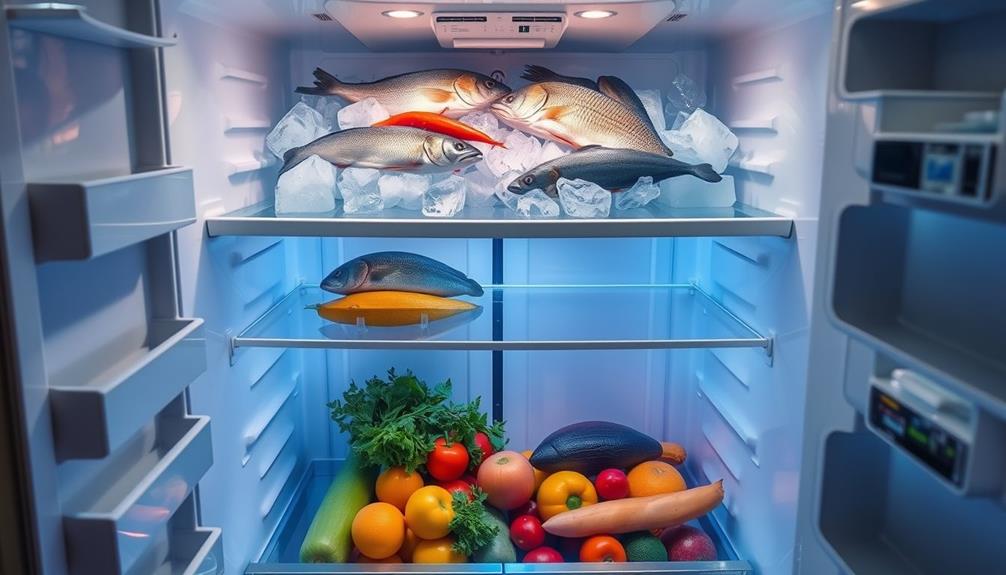
When storing fish, it's vital to prioritize proper storage techniques to keep it fresh and safe.
You should always maintain the right temperature and take steps to prevent cross-contamination, especially with other raw foods.
Regular cleaning of storage areas is essential to guarantee hygiene and minimize the risk of foodborne illnesses.
Importance of Proper Storage
Storing fish correctly is essential for maintaining its freshness and guaranteeing food safety. To prevent contamination, always place fish on the top shelf of your refrigerator. This helps minimize the risk of juices leaking from raw meats or poultry stored below, which could spoil your fish.
Additionally, consider incorporating aquatic exercise into your routine, as it promotes overall health which is beneficial when handling and preparing food. Wrapping your fish tightly in plastic wrap or aluminum foil is important, as it prevents exposure to contaminants and helps maintain its quality.
Be certain to store fish in a sealed container, keeping it separate from raw meats and poultry. This extra layer of protection further reduces the risk of cross-contamination.
Regularly check the use-by dates on your fish to verify you're consuming it while it's still safe. Proper refrigeration is essential; keep your fish at or below 5 °C to inhibit harmful bacteria growth.
Temperature Control Guidelines
Maintaining the right temperature is essential for guaranteeing your fish stays fresh and safe to eat. Store your fish on the top shelf of the fridge to avoid cross-contamination with other raw foods like beef and pork. The ideal storage temperature for fish is below 5 °C, which helps minimize bacterial growth and keeps it fresh.
Here's a quick overview of proper fish storage:
| Storage Guidelines | Details |
|---|---|
| Ideal Temperature | Below 5 °C |
| Storage Location | Top shelf of the fridge |
| Wrap | Tightly in plastic wrap or aluminum foil |
| Below Fish | Whole cuts of beef and pork |
Always check the temperature of your fridge regularly to guarantee it stays at or below that critical level. Wrapping your fish tightly prevents exposure to contaminants, further maintaining its quality. Following these temperature control guidelines will help keep your fish safe and delicious for you and your family.
Cross-Contamination Prevention Strategies
To keep your fish safe from cross-contamination, always place it on the top shelf of your refrigerator. This prevents fish juices from dripping onto other raw foods, reducing the risk of spoilage and bacteria spreading.
Proper food handling and storage practices are fundamental to maintaining a safe kitchen environment, especially when it comes to preventing cross-contact with other raw ingredients.
Here are three fundamental strategies for storing fish correctly:
- Use a Sealed Container: Store your fish in a well-sealed container or tightly wrapped to minimize any leakage. This is critical in preventing cross-contamination with other foods.
- Separate Storage: Always keep fish separate from raw poultry and meats. These should be placed on the lower shelves to avoid any drips that could contaminate the fish.
- Monitor Temperature: Verify your refrigerator maintains a temperature of 5 °C or below. This is essential for temperature management and helps inhibit bacterial growth, keeping your fish fresh longer.
Regularly check your fish for signs of spoilage and consume or cook it within a safe timeframe.
Poultry Safety Practices
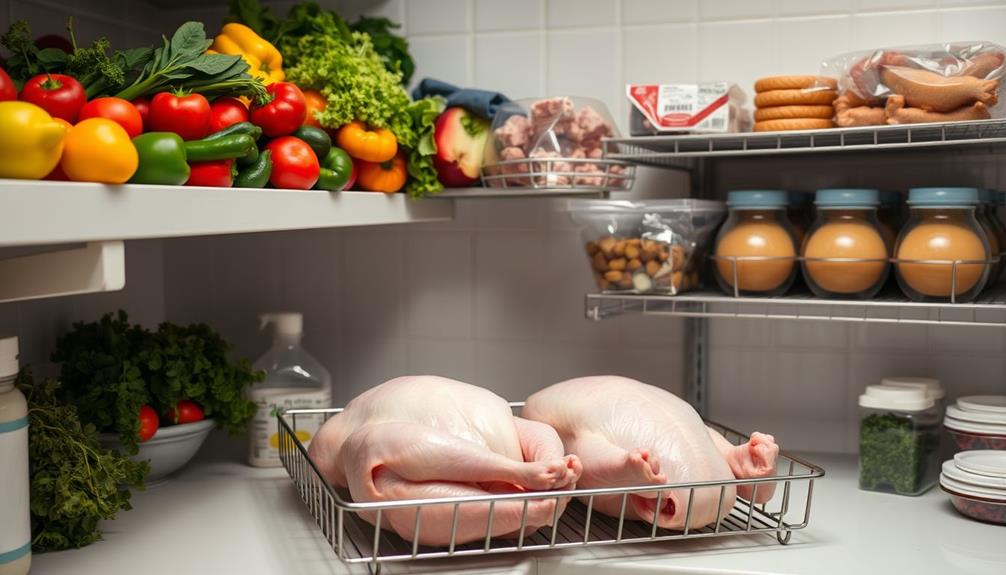
When it comes to poultry safety, proper storage is key to preventing foodborne illnesses. Always store raw poultry on the bottom shelf of your fridge to avoid cross-contamination, and make sure it's in a sealed container.
Additionally, understanding the importance of budgeting for food expenses can help you manage your grocery costs effectively.
Keeping poultry at safe cooking temperatures is just as important—let's explore how to do this effectively.
Proper Storage Hierarchy
Properly organizing your refrigerator is vital for poultry safety and overall food hygiene. Establishing a clear storage hierarchy helps prevent cross-contamination and guarantees your food stays safe.
For instance, keeping your raw meats properly stored can greatly reduce the risk of foodborne illnesses, as noted in hamster care and costs regarding proper food handling.
Here's how you can organize your raw foods effectively:
- Top Shelf: Store whole fish here. Keeping it above all other raw foods minimizes cross-contamination risks.
- Middle Shelf: Place whole cuts of beef and pork on this level, guaranteeing they're below fish but above ground meats. This organization helps maintain proper cooking temperature guidelines.
- Bottom Shelf: Raw poultry belongs here to prevent its juices from dripping onto other foods, especially ready-to-eat items located above.
Always wrap your raw foods securely in plastic wrap or aluminum foil to prevent leakage and contamination within the fridge.
By following this structured organization, you greatly reduce the chances of harmful bacteria spreading among your food.
Avoid Cross-Contamination Techniques
Cross-contamination is a serious concern in the kitchen, especially with raw poultry. To guarantee food safety, always store raw poultry on the bottom shelf of your refrigerator. This prevents its juices from dripping onto other foods, which can lead to harmful bacteria spreading. Use a sealed container or plastic bag to minimize any risk of leakage.
Early detection of foodborne illnesses can be vital, much like the importance of mammography for early detection in breast cancer.
It's essential to follow the food hierarchy; store raw poultry above raw meats and seafood. This simple step can considerably reduce the risk of cross-contamination. When preparing meals, always use separate cutting boards for raw poultry and other ingredients to avoid cross-contact of pathogens like Salmonella.
Maintaining proper refrigeration temperatures is vital, too—ideally below 5 °C. This inhibits the growth of harmful bacteria that can thrive in warmer environments. Regularly check your refrigerator to guarantee it's keeping the right temperatures.
Safe Cooking Temperatures
Cooking poultry safely is vital for preventing foodborne illnesses. To guarantee you're cooking your poultry properly, always check the internal temperature with a food thermometer. The safe cooking temperature for all poultry products, including whole birds and ground poultry, is 165°F (74°C).
It's essential to maintain a clean cooking environment and utilize proper food storage practices for peak safety, especially if you have pets that might introduce allergens into your home, as best vacuums for dust removal in 2024 can help eliminate any lingering particles.
Here are some key tips to follow:
- Store Raw Poultry: Always keep raw poultry on the bottom shelf of your fridge to prevent juices dripping onto other foods and causing cross-contamination.
- Thawing Methods: Thaw frozen poultry safely in the refrigerator, in cold water, or in the microwave. Avoid thawing at room temperature to minimize bacterial growth.
- Leftover Cooked Poultry: Refrigerate any leftover cooked poultry within two hours of cooking. Consume it within 3-4 days for peak food safety.
Managing Raw Meat Storage
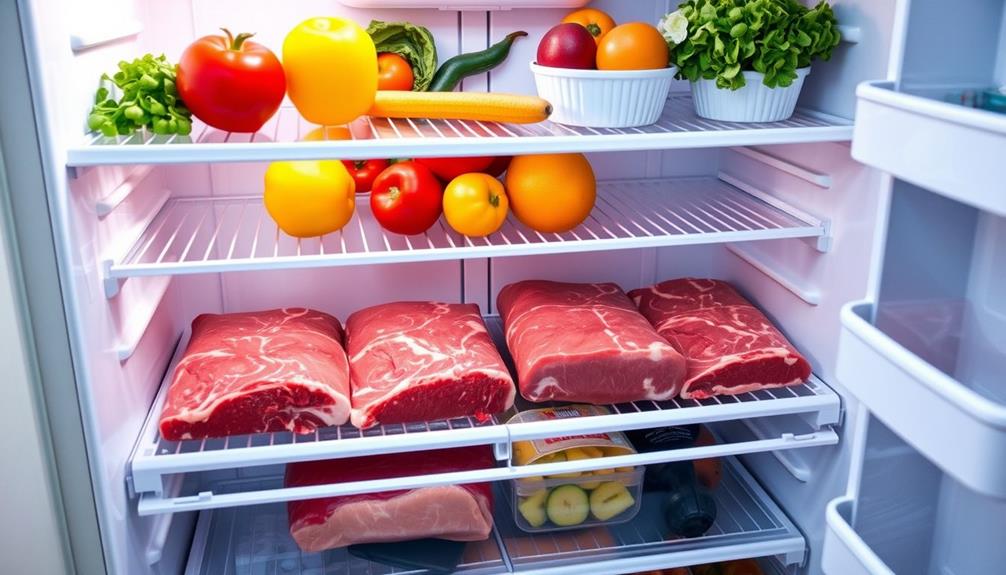
When it comes to managing raw meat storage, organization is key to ensuring food safety.
Start by storing fish on the top shelf of your refrigerator. This placement minimizes the risk of contamination with other raw foods.
It's also important to maintain a clean refrigerator environment to prevent any airborne bacteria from settling on surfaces, much like the air purifier maintenance dos and don'ts.
Below the fish, place whole cuts of beef and pork on the middle shelf. This arrangement prevents any drips that could potentially contaminate lower shelves.
Ground meats, including beef and pork, should occupy a lower shelf to reduce the risk of bacterial spread from their juices.
Preventing Cross-Contamination
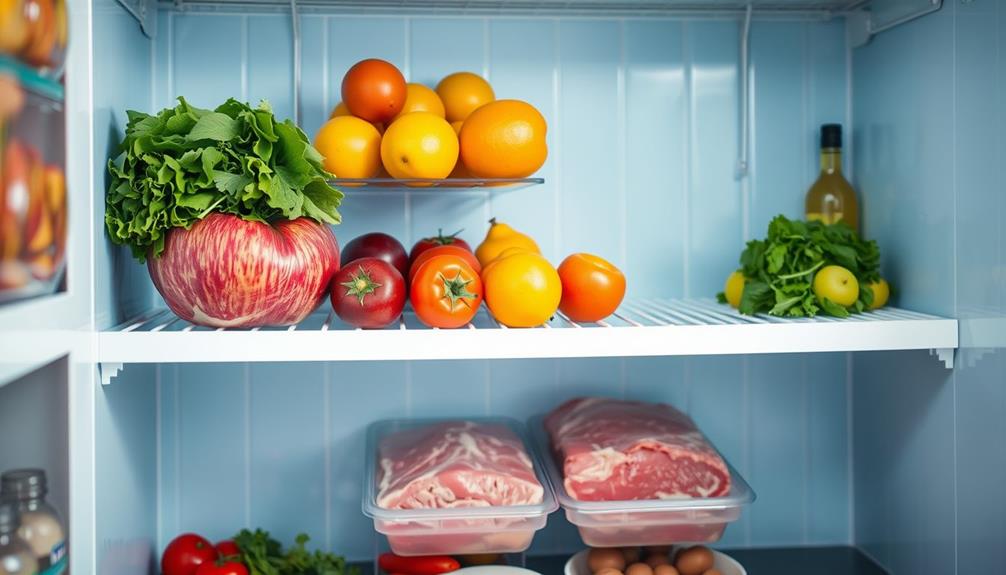
Maintaining a safe food environment means taking steps to prevent cross-contamination in your kitchen. To keep harmful bacteria at bay, you need to store raw foods correctly and guarantee that they're separate from cooked foods. Here are some essential tips to help you achieve that:
1. Store Raw Foods in Order: Always place fish at the top, followed by whole cuts of beef or pork, ground meats, and finally poultry at the bottom. This arrangement minimizes the risk of drips and leakage contaminating other items. Additionally, it’s important to store raw foods in sealed containers or leak-proof bags to further prevent cross-contamination. When storing raw foods in the refrigerator, always keep them separate from ready-to-eat items, and use different cutting boards and utensils for preparing raw meats and other foods. Following these raw food storage tips can help reduce the risk of foodborne illness and keep your kitchen safe.
Additionally, just as proper maintenance is vital for heat pumps to function effectively, maintaining proper food storage practices is fundamental for food safety.
2. Use Sealed Containers: Keep raw foods in sealed containers or plastic bags. This greatly reduces the chances of leakage, which can spread harmful bacteria and lead to foodborne illnesses.
Using sealed containers is similar to how energy-saving features in heat pumps help minimize inefficiencies and enhance performance.
3. Organize Food Storage: Regularly check and organize your food storage. Confirm that cooked foods are always stored above raw items to maintain that vital separation.
Food Safety Guidelines
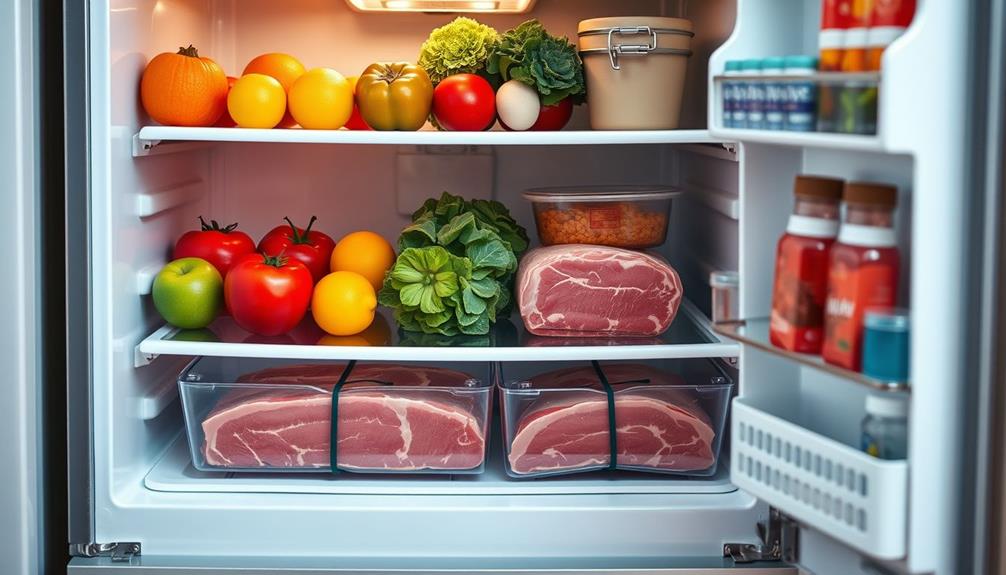
Food safety guidelines are essential for guaranteeing that your raw ingredients remain safe to eat and won't lead to foodborne illnesses. To maintain a safe storage hierarchy, place raw fish at the top of your refrigerator. This minimizes the risk of cross-contamination from its juices.
Additionally, understanding the importance of proper food handling can greatly reduce health risks associated with foodborne pathogens, similar to the ways caregivers manage financial considerations for elderly care to guarantee safety and well-being.
Below the fish, store whole cuts of beef and pork, which are less likely to harbor harmful bacteria compared to ground meats. Ground meats, like ground beef and pork, should be stored beneath whole cuts to prevent bacterial spread.
Finally, keep raw poultry—such as whole and ground chicken—on the bottom shelf, as it poses the highest risk of carrying pathogens like salmonella.
Always wrap your raw foods securely in aluminum foil or plastic wrap. This prevents exposure to contaminants and avoids any leakage that could affect other foods in your fridge.
Best Storage Containers
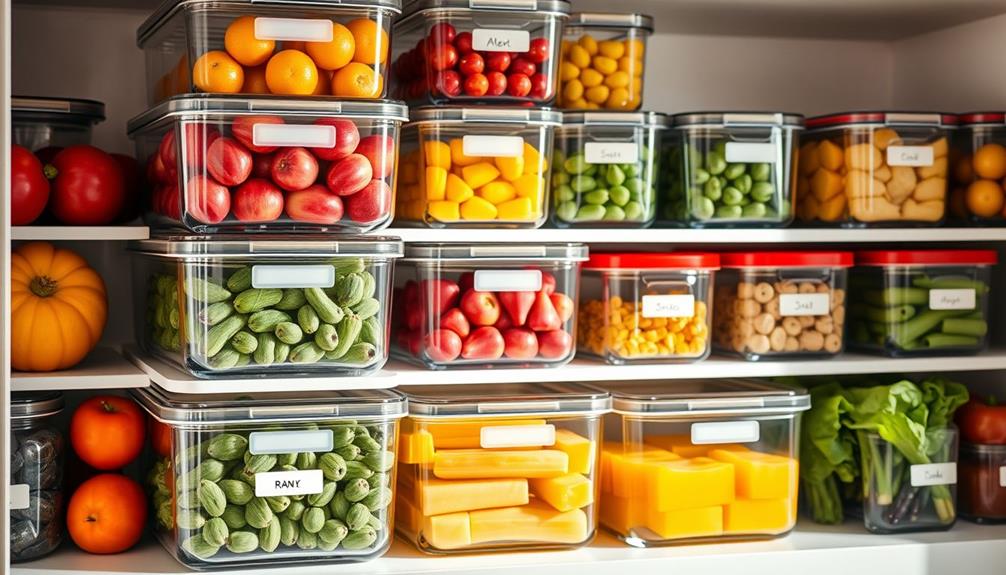
Choosing the right storage containers can make a big difference in keeping your raw foods safe and fresh. To effectively prevent cross-contamination and maintain the quality of your ingredients, consider these tips:
- Use airtight containers: Opt for glass or BPA-free plastic containers with tight-fitting lids. They not only prevent leaks but also keep odors from mingling and help maintain freshness.
- Label everything: Clearly label your storage containers with the contents and date of storage. This practice guarantees you track use-by dates and minimizes the risk of using spoiled food.
- Create visual distinction: Utilize separate colored containers for different food groups like raw meat, poultry, and seafood. This method aids in easily identifying contents and greatly reduces cross-contamination risks.
For freezer use, choose thicker food storage bags designed for that purpose. They're less likely to puncture or leak, guaranteeing your raw foods stay safe.
Frequently Asked Questions
Which Raw Food Should Be Stored Above?
When storing raw foods, you should place whole fish on the top shelf. This helps reduce cross-contamination risks. Remember to wrap them securely to prevent any leaks that could affect other items below.
Which Food Should Be Stored Above?
Imagine the chaos of a kitchen gone wrong. You should store fish on the top shelf to prevent cross-contamination. It's essential for maintaining safety, ensuring your meals are delicious and free from any harmful bacteria.
Which Food Should Be Stored Above Others in the Refrigerator?
When storing food in your refrigerator, always place fish on the top shelf. It minimizes cross-contamination risks. Below that, keep whole cuts of beef and pork, followed by ground meats and poultry on the bottom.
What Is the Proper Way of Storing Raw Food?
Imagine your fridge as a well-organized library. When storing raw food, wrap it tightly, use sealed containers, and arrange by type. This keeps everything fresh and prevents contamination, just like protecting valuable books from damage.
Conclusion
By understanding the importance of food hierarchy and proper storage techniques, you can keep your kitchen safe and your meals delicious. Just like stacking building blocks, each layer of food needs to be placed thoughtfully to prevent disaster. Remember to store fish above poultry, and always keep raw meat at the bottom. With these tips, you'll guarantee freshness while protecting your loved ones from cross-contamination. Your kitchen can be a safe haven for healthy eating!
Rachael, the Editor in Chief of RachaelsRawFood.com, is an inspiring and passionate individual who has dedicated her life to promoting the benefits of a raw food lifestyle. Known for her vibrant and energetic personality, Rachael has built a strong online presence that has transformed her personal journey into a thriving community of raw food enthusiasts.
-
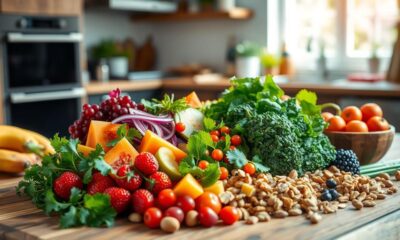
 Health and Wellness2 months ago
Health and Wellness2 months agoDoes Eating Raw Food Help You Lose Weight? Discover the Truth
-

 Kitchen Essentials for Raw Food Preparation1 month ago
Kitchen Essentials for Raw Food Preparation1 month agoCan You Cook Raw Food in an Air Fryer? Discover the Possibilities
-

 Raw Food Recipes2 months ago
Raw Food Recipes2 months agoHow Much Raw Food to Feed Your Puppy: Essential Tips
-

 Raw Food Recipes2 months ago
Raw Food Recipes2 months agoHow to Defrost Dog Raw Food Properly
-
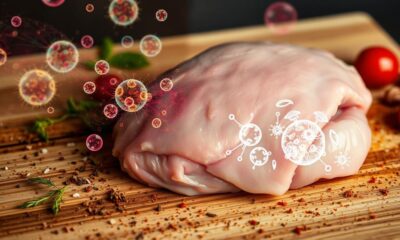
 Health and Wellness2 months ago
Health and Wellness2 months agoHow Long Does It Take Bacteria to Spread From Raw Food? Essential Info
-
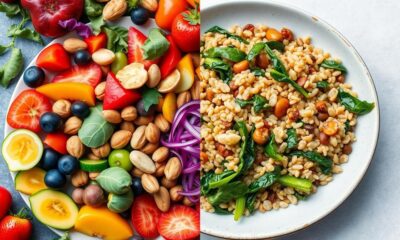
 Raw Food Recipes2 months ago
Raw Food Recipes2 months agoRaw Food Vs. Vegan: Which Diet Is Better?
-
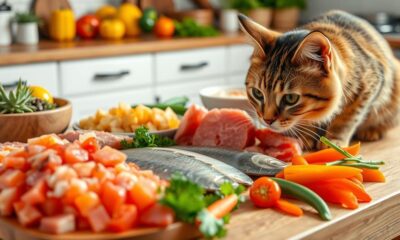
 Raw Food Recipes2 months ago
Raw Food Recipes2 months agoIs Raw Food Good for Cats? Find Out Here
-
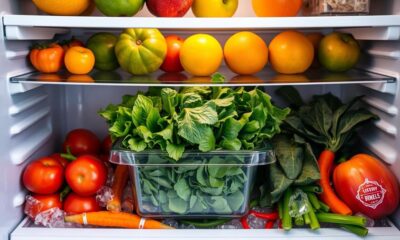
 Kitchen Essentials for Raw Food Preparation4 weeks ago
Kitchen Essentials for Raw Food Preparation4 weeks agoWhich Raw Food Should Be Stored Above? Essential Tips


